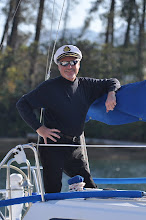Don't Take My Kodachrome Away!
Today's San Francisco Chronicle:
"The photography show is called "The Last Kodachrome" but the last Kodachrome images aren't in the show. They are still in Pat Willard's Nikon camera.
They will have to come out by next week because the last lab in the world that processes the famed color film, Dwayne's Photo in Parsons, Kan., is discontinuing it at the end of the year. The last rolls to be processed must be there by noon, Dec. 30. After 75 years, all that will be left of Kodachrome is the Paul Simon song, and a state park named after it in Utah.
There will still be a sister film called Ektachrome, but Willard, a fine art photographer in Redwood City, is not buying it.
"I'll probably do only black and white," he says, lowering his tone to a funereal whisper. "There's no color like Kodachrome."
When the Eastman Kodak Co announced that the last rolls were hitting the shelves, in June 2009, Willard bought 40 rolls, at $8 apiece, and stuck them in the fridge of his townhouse in Redwood Shores. Then he contacted Ann Jastrab, director of Rayko Gallery, proposing a juried exhibition for Kodachrome prints.
Fifty photographers nationwide, plus a few from Canada, northern Europe and South Africa, sent in portfolios. Twenty-one photographers were selected and 45 prints are in the show, which opened Dec. 17 and, after a Christmas break, will reopen Jan. 4. Included are four prints of Willard's abstract expressionist work.
The other day he was compelled to sit on the couch of his townhouse and describe his love affair with Kodachrome.
"The color balance is what I like," he says, after thinking it through. "It's warm and voluptuous."
High maintenance, though. Unlike other color film, Kodachrome starts as black-and-white film. Color dyes are added in the lab, like printmaking, which is why you can't develop it at home.
"It's the most complicated film there is to process," says Todd Gustavson, a curator at the George Eastman House, in Rochester, N.Y. Dwayne's in Kansas is the last licensed processor, and doing 700 rolls a day, twice its average.
Introduced in 1935, Kodachrome was the first commercially successful color film, says Audrey Jonckheer, manager of worldwide public relations for Kodak film. Derived from motion picture film, it has always been developed in slide form and coincided with the rise in popularity of the slide projector.
"It had a color saturation that is unmatched with any other slide film or with digital," says Lou Dematteis, a San Francisco freelance photojournalist who has 10 pictures in the Rayko show, more than any other contestant. "Kodachrome I shot in the 1970s is still as vibrant as it was when I first processed the film."
Dematteis had to switch to digital because that's what all the news agencies use. His book "A Portrait of Vietnam," published in 1996, is Kodachrome, but his follow-up on Ecuador, "Crude Reflections," 2009, is a mix of film and digital.
"I show it to people, and if they are in the know, they will look and say, 'That's not digital. That's Kodachrome.' "
The last roll Kodak manufactured was given to Steve McCurry, who shot the famous Kodachrome image of the green-eyed Afghan girl that was on the cover of National Geographic in June 1985. Last spring, he used up the roll in New York City and India, and the prints will eventually be on display in 2011 at the Eastman House museum.
Pat Willard's own last roll of Kodachrome won't be displayed anywhere. He's putting it in a glass case to display on his mantel, right next to his antique Argus C3 camera.".
I ask, what next in this life? What next?

1 comment:
I saw them feature it this morning on the CBS morning news. (that's one of hubby's favorite weekend shows) I wasn't aware, never knew much about photography. Sad to see such wonderful things go. Especially now that I'm a bit more privy to it.
Post a Comment